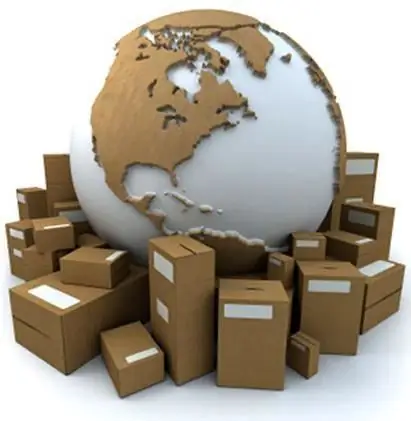2026 Author: Howard Calhoun | [email protected]. Last modified: 2025-01-24 13:10:37
Each unit of product cleared at customs posts undergoes a special identification process. As a result, it receives the code of the commodity nomenclature of foreign economic activity. This procedure, carried out within the framework of the current legislation of Russia, allows you to carry out a number of economic transactions. These include, in particular, payments, costing, planning and reporting. In addition, the unified commodity nomenclature of foreign economic activity (TN VED) makes it possible to study the structure of international trade.

Features of the modern TN VED of Russia
The basis used in the customs authorities of the Russian Federation TN VED, served as the global system of classification and detailed description of product units. The modern commodity nomenclature of the foreign economic activity of the Russian Federation is divided into 21 sections and 97 groups. They are united according to the principle of unambiguous characteristics of units of production. The criteria used in the construction of the classification system,are:
- material of manufacture of goods;
- basic functional tasks;
- workmanship.

The most common unit of measure is the mass of goods expressed in kilograms.
When assigning the corresponding TN VED code to a product, three parts are used:
- nomenclature;
- notes to groups and sections;
- rules for determining the main functions of products.
Incorrect classification as a result of indicating incorrect data in the declaration entails liability under the current legislation of Russia.
Functions of TN VED and HS
Commodity nomenclature of foreign economic activity of the Customs Union allows to unify all imported units of production with national ones. As a result, the compatibility of world commodity systems is ensured. This, in turn, affects the efficiency of international trade. Most countries and customs unions use the universal Harmonized System (HS) in their work. A general procedure and rules for assigning item numbers to goods was developed and implemented. The status of the HS is enshrined in a special provision of an international convention. The transition to a common nomenclature has greatly facilitated the turnover between the subjects of the world market.
Application of TN VED in customs clearance
The commodity nomenclature of foreign economic activity used by most countries is clearly structured and detailed. It builds on its basisall taxes on products. In this regard, the classification system is the main and most effective means for the formation of the general policy of the state in the field of tariff and customs regulation. The international trade structure uses certain methods of influencing the global market (both in general and on its subjects). These include:
- regulation of customs tariffs or taxes;
- introduction of conditions of restriction, agreement and contract between participants in market relations;
- activities aimed at increasing imports or exports.

Customs-tariff and non-tariff regulation measures based on TN VED
Foreign trade activity of the Russian Federation is regulated by the relevant law. The regulation allows the use of tariff and non-tariff methods. The main function of customs tariff methods is the protection and development of the internal market. Non-tariff methods are expressed in the form of determination by the state of the norms within which the import and export of goods of certain nomenclatures is carried out. The commodity nomenclature of foreign economic activity is a financial element of regulation of the volume of trade with other countries by the state. Based on it, cost indicators for a certain type of goods are formed. However, the customs and tariff regulation of the state is not the main task of the FEACN. First of all, the commodity nomenclature of foreign economic activity makes it possible to reduce time costs forcustoms clearance. In addition, with its help, the quality of service is improved, statistical records are kept using world standards.

Globalization of the world market forced its participants to look for new tools to control the movement of goods. There was a need to keep records of the movement of substances dangerous to human life, as well as species that are on the verge of biological extinction. As a result, on the basis of international legal mechanisms, a more detailed system of world classification began to emerge, focused primarily on the goals of the customs authorities of the subjects of the interstate market. At the same time, the opportunity was retained to refine the overall coding structure to the needs of each market participant, while not violating the principles of international nomenclature.
Functions of TN VED
Commodity nomenclature of foreign economic activity consists of a detailed description of units of production and its classification in a numerical value (10 characters). This is necessary to facilitate the following processes:
- customs and tariff regulation;
- non-tariff control;
- statistical research;
- forming a digital detailing system.
Using TN VED when making a customs declaration for goods allows you to:
- use a unified approach to product classification;
- correctly calculate the amount of customs duties;
- collect the necessary package of accompanying documents forproducts;
- process and structure product information within the framework of statistical research.

Customs statistics
Foreign economic activity of the Russian Federation is regulated on customs statistical data, the basis for structuring which is the classification according to the FEACN. Using this classification system allows you to solve the following problems:
- keep records of goods that have passed customs control;
- introduce non-tariff ways to regulate imports or exports;
- promptly respond to changes in the global market.
There is a specially developed and approved methodology for collecting customs statistics in Russia. It is used for objective and timely formation of customs statistics, preparation of specialized collections and analytical materials. In accordance with them, the study and analysis of Russia's trade relations with its market partners - other countries is carried out. Customs statistics include only goods, it does not capture trade in services.
Recommended:
Nomenclature of affairs of the organization: samples of filling. How to make a nomenclature of affairs of the organization?

Each organization in the process of work is faced with a large document flow. Contracts, statutory, accounting, internal documents… Some of them must be kept at the enterprise for the entire period of its existence, but most of the certificates can be destroyed upon expiration of their validity. In order to be able to quickly understand the collected documents, a nomenclature of the organization’s cases is compiled
Gold and foreign exchange reserves of the countries of the world. What is it - a gold and foreign exchange reserve?

Gold and foreign exchange reserves are the reserves of foreign currency and gold of the country. They are kept in the Central Bank
Foreign economic activity is Management of foreign economic activity

Foreign economic activity is the activity of the state in the sphere of the economy outside of domestic trade. It has many different aspects, but all of them are somehow connected with the market, the promotion of various kinds of services on it: transportation, sale of goods. In fact, it is a complex system consisting of many interdependent links
Manager for foreign economic activity (foreign economic activity): tasks, duties, requirements

Foreign trade manager - who is this? Two main lines of business and day-to-day tasks. The main duties of a specialist. Requirements for the applicant, the necessary personal qualities. Consider the pros and cons of the profession. How to become a foreign trade manager? Getting started and career advancement. The question of wages
FSS: confirmation of the type of activity. When and how to confirm the main activity in the FSS

According to the updated legislation, all business entities must confirm the main type of economic activity (OVED). In 2017, this procedure has undergone some changes. What did they touch: documents, deadlines or responsibility? Let's try to figure it out

